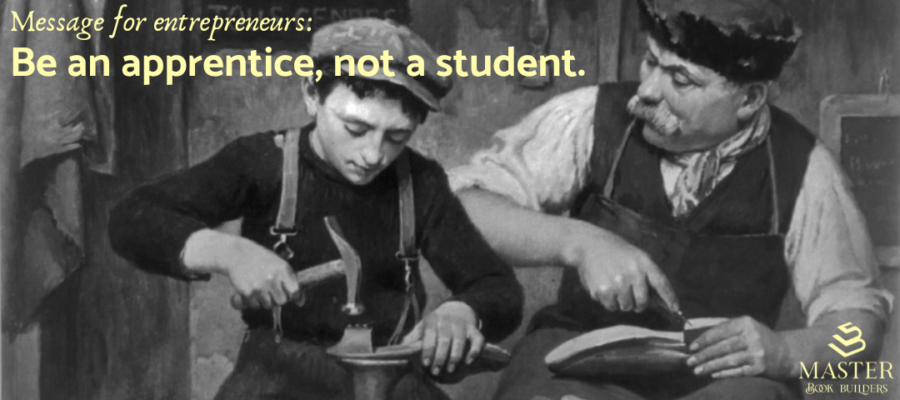The Entrepreneur’s Apprentice: Creating Your Business Owner’s Learning Environment
“Be an Apprentice, Not a Student,” advises our friend and business coach Mary Anne Shew. Does that mindset resonate with you? It sure did for me!
If you agree that learning should remain at core of how you work and live, let’s take a look at how adopting an apprenticeship mindset and finding a partner or group to practice it with can help you and your business grow.
Apprentice vs. student: What’s the difference?
Mary Anne’s advice focuses on one main difference: apprentices learn a skill or trade in the workplace, while students learn from a teacher in an academic setting away from work. She wisely suggests that you keep an apprentice mindset and always look for ways to apply new learning in the work you do.
This important distinction between apprentice and student struck me in another way: the depth of their commitment.
Apprentices (and “masters”) are ALL IN
Students take courses from teachers and may or may not be working toward a degree, which may or may not lead to a job. Generally, the student pays or has someone paying for the education and the teacher gets paid for delivering it.
The classic apprentice, though, signed an indenture agreement for seven years of on-the-job training, leading toward a lifelong trade or calling. The apprentice joined the master’s household. If all went well, the apprentice might become a partner in the master’s business, eventually taking over when the master left. Or the apprentice might complete the training, become a master, and start his own shop.
The master’s commitment was equally serious. For seven years, he provided full support, essentially bringing the apprentice into his family. The master had a strong incentive to help the apprentice achieve competence as quickly as possible. The sooner the apprentice could produce quality work, the sooner the master could start enjoying a return on the major investment of time and energy in the training process.
Both parties invested a lot in learning. And they worked together for mutual long term benefit.
Nowadays, education theorists embrace the “apprenticeship perspective” on learning as being more holistic, involving learning by both the student and the teacher.
A key concept is “sociality” — recognizing the value of the student interacting with the tools and practices of the trade, co-workers, teachers, AND the customers of the business, all in their actual workplace setting. The apprenticeship learning environment benefits all participants. As the newer members grow more capable and apply their learning to new problems or in new ways, they contribute to growing and refreshing the entire group’s body of knowledge.

What’s your learning plan?
Mary Anne’s main point: you should have one.
She begins by comparing the ways that employees and business owners get ongoing training and professional development. Employers generally understand the need for such ongoing growth and development in their workforce. The most enlightened employers provide — and pay for — the time and resources needed, from reference materials, to offsite conferences, to college courses and even advanced degree programs.
I learned a lot about individual learning plans from working with Dr. Lee Thayer on his book, Leadership: Thinking, Being, Doing. As the title implies, the book focuses on developing yourself into a leader, first and foremost ready to lead yourself.
Among the barriers to growing a business, he warns against falling into “the knowing mode,” a state shared by most adults. In the knowing mode, we use our accumulated bits of knowledge and experience to construct a view of how our world, including the work we do, works. We “know” the answers to the questions we face each day and too often resist, reject, or ignore any information that might upset that comfort zone. An entrepreneurial apprenticeship can help you sidestep this potential pitfall.
Thayer contrasts knowing mode with the insatiable curiosity we all shared as children. How would that work in our adult roles and our work, where he acknowledges we have to “know” a lot of stuff to function? By seizing the “great advantage” of
considering everything we know as provisional — that is, subject to revision or elimination when something better or more useful comes along.
Being in “the learning mode” means being curious, open to new, sometimes contrary ideas, and spending more time asking than telling. Learning mode enables us to explore, discover, invent new answers to our daily questions, new solutions to our problems.
Keeping everyone in an organization in learning mode, including the leader — no, especially the leader — is a core stratagem for growth. And requiring a learning plan for everyone — again, especially the leader — is a basic tool of leadership. He describes a learning plan as a tool for systematically improving a person’s capacities for doing their work, performing their roles — for asking better questions.
And he describes the leaders’ role in this context as “coaching” to continuously improve the performance capabilities of their team, “to make self-leaders of their people.” Sound a bit like the apprenticeship model?
In an organization, of course, nearly everyone will find themselves alternating the roles of coach or learner at different times. If you’re a solopreneur or part of a small startup team, you’re used to wearing multiple hats and shifting between roles all the time, right? Add creating and implementing a learning plan for your entrepreneurial apprenticeship to your list!

How some big businesses invest in learning environments
Two monumentally successful companies, Google and 3M, take it a step further and encourage employees to invest paid “company time” in their own projects. 3M calls its 15% program “time to think” and asks,
What would you do if you had access to world-class laboratories and scientists, and almost one day a week to investigate a new idea?”
I’m struck by how well that ties back to the “sociality” concept in apprenticeship learning: enabling access to tools, co-workers, and time to learn in the workplace, with an eye toward producing something of value to your customers.
Google ‘s 20 percent time program is less official and the company’s enthusiasm for it seems to wax and wane. But as Ryan Tate wrote in Wired years later, Google didn’t invent the concept. Many profitable innovations at many companies trace back to these investments in employee’s exploration, experimentation, expansion of learning. A Harvard Business Review article credits the 3M 15% rule as having a major role in products like Post-It adhesive and an astounding 30% of its products being invented in the last four years.
Capturing the value of these corporate learning plans, Tate asked, “What’s the point of an experiment if you’re not going to act based on what you learn?”
Which is exactly why you need a learning plan as a solo/small business owner: your investment of time and money in your ongoing growth and development should be aimed at making your business better. An entrepreneurial apprenticeship can help. That may mean coming up with new (for you) products or services, improving how your produce and deliver what you’re already offering, or learning how to make more money on your effort.
Planning your entrepreneurial apprenticeship
Back to Mary Anne’s advice, if you’re an entrepreneur just getting started or a small business owner focused on growing faster, it’s easy to devote all your energy to setting up and running the business. But she warns, getting the training and support you need to grow yourself and your business over the long haul “is now completely up to you.”
So if her advice to “be an apprentice” also makes sense to you, what could that look like for you? What if you could blend together the best parts of Thayer’s individualized learning plans, Mary Anne’s apprenticeship concept, and 3M’s “time to think” in a world-class laboratory environment?
Here are the main characteristics that I think you should be looking for in an “entrepreneurial apprenticeship” learning environment:
- access to one or more entrepreneurs who have achieved success, but who retain that insatiable curiosity essential to staying in the learning mode
- interaction with others on paths similar to yours at varied levels of progress, who are eager to switch between master and apprentice roles in a blink
- a collaborative workspace, tools, and activities that will encourage experimentation and expand your skills in ways you can apply to achieving your business goals
- a growing virtual “library” of archived learning that you can access from your own work place when you need it, along with communication tools for asking for additional help when you need it
- opportunities to contribute your own knowledge and fill the master role for others when you’re ready
As I’m betting you’ve guessed, this post describes some of my goals for Old Dog Learning and the Professional Learning Partnerships I’m offering to form with you.
And I’ll be staying in the learning mode right along with you.
So please jump in, ask great questions, and share your ideas for how we can make this a world-class learning environment, designed ideally for you. What else should you be looking for from me and this environment?
[Note: I published an earlier version of this post in 2016 on the BlogPaws Social Learning Community blog, but it got lost when moving to a new platform.]
Photo on header image: a public-domain reproduction of “Apprentice,” a painting by Emile Adan, c. 1914, courtesy of the U.S. Library of Congress.





Leave a Reply